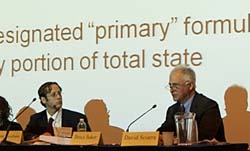Examining the Education Bailout
How do funds address educational inequities?
This year’s Educational Equity Symposium, held February 8 and 9 in the Cowin Conference Center
According to professors, public policy analysts and government officials at the Symposium, most states have used the federal bailout money to avoid massive layoffs in school districts reeling from recession-gutted budgets. But based on detailed analysis of funding applications and budget documents, many states took advantage of flexibility in the law to do things that were contrary to the expectations of the U.S. Department of Education (USDOE), which distributed the grants. Some states used bailout funds intended for low-income or special-needs children for other programs, or spent the money according to state funding formulas that perpetuate funding inequities between wealthy and poor districts.
“Some states kept inequitable funding formulas in place,” said Bruce Baker of Rutgers University , who examined the records of 11 states with David G. Sciarra and Danielle Farrie of the Education Law Center in Newark , New Jersey
A study presented by Michael A. Rebell, Director of The Campaign for Educational Equity, found that all 20 states examined by the Campaign used the federal bailout money to fill in severe budget deficits, rather than for measures that would result in long-term reform, one of the stated aims of the stimulus bill. Rebell co-authored the study with Jessica A. Wolff, the Campaign’s Policy Director, and Daniel A. Yaverbaum, a researcher with the Campaign.
Research presented by Jack Jennings, President and CEO of the Center on Education Policy, found that 44 states have already spent up to 70 percent of the two-year grants provided by ARRA, raising questions about whether the states will hit a “funding cliff” and run out of money before 2012. The study also cast doubt on whether states will be able to keep education funding above 2008 or 2009 levels, which Congress would like them to maintain. Midyear budget cuts this year have already pushed some state education budgets below these figures, Jennings
States accepting federal funds were required to assure the USDOE that they would make progress on four reform measures. They needed to establish or improve data systems to track student progress; improve testing to more accurately gauge how students are doing; improve or close under-
performing schools; and improve teacher quality and the fair distribution of qualified teachers to poorer school districts.
performing schools; and improve teacher quality and the fair distribution of qualified teachers to poorer school districts.
Jennings said states made progress in the first two categories, largely because most had already begun to address them. But they mostly failed the requirement to move better teachers into low-performing schools or take other steps to improve them, mostly because they do not have the capacity to absorb and quickly spend a large infusion of federal aid. “We’re trying to put the spotlight on the lack of capacity at the state level,” he said.
In order to spend the funds quickly, states expanded the number of students who qualified for low-income assistance in programs such as Title I. According to research presented at the symposium, once the federal money runs out, states may not be able to maintain services to those extra students. “The federal government is promising reforms way beyond what it’s capable of carrying out,” said Maris S. Vinovskis, Professor of Public Policy at the Gerald R. Ford School of Public Policy at the University of Michigan
Rebell, an attorney who successfully sued New York State on behalf of New York City plaintiffs in an educational equity lawsuit, said states’ inattention to the education of poor students violates their constitutional rights, which should be protected in good economic times as well as bad. “Constitutional rights are not conditional and do not evaporate during times of recession,” he wrote in another paper on the constitutional implications of the bailout program, presented at the symposium. “Children’s need for meaningful educational opportunity cannot, therefore, be deferred because tax receipts are lagging.”
Keynote addresses were delivered by Governor Edward G. Rendell of Pennsylvania (who spoke live via video conferencing), who has kept funding educational equity provisions in his state as scheduled, despite the current economic downturn, and Russlynn Ali, Assistant Secretary for Civil Rights, U.S. Department of Education, who is responsible for enforcing civil rights law in schools.
The symposium also included a panel discussion on New York City and New York State , including Daniel Lowengard, Superintendent of Syracuse schools, and Mary Anne Schmitt-Carey, President of Say Yes to Education in Syracuse Massachusetts , participated with Jennings
To view video and papers from the conference, visit www.tc.edu/symposium/ .
Published Tuesday, Mar. 23, 2010


